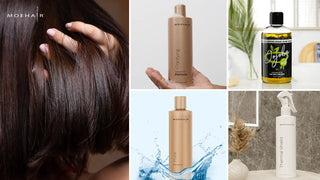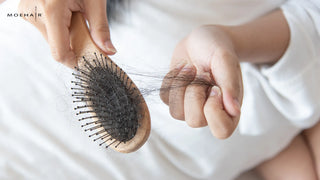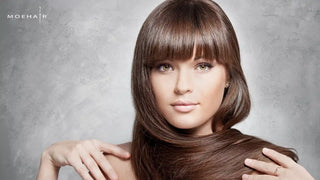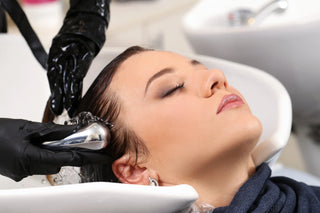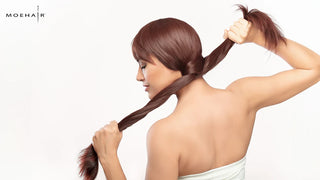 Table of contents
Table of contents
Losing that bounce in your hair? Do you feel the change in hair volume? No matter the clever cuts and styling, if your ponytail feels limp or your scalp starts to show, perhaps hair thinning or hairfall is knocking at your doorstep. GH Beauty Lab Director Sabina Wizemann explains, “There could be a multitude of causes, often involving a combination of genetics, age, hormonal changes, lifestyle, health conditions, physical or emotional stress or simply from poor or wrong haircare practices.”
This guide walks you through seven proven tips and tricks to help you achieve the thicker, healthier hair you’ve always wanted.
1. Hair-healthy diet
Healthy hair starts from within. Make sure your diet is rich in nutrients like protein, iron, zinc, and more to improve hair thickness.

- Omega-3 fatty acids - Found in salmon, chia seeds, and walnuts, omega-3s nourish roots and follicles and add shine. Incorporate flaxseed oil into your diet if you’re looking for a vegan-friendly option.
- Protein - Hair is primarily made of keratin protein. Include eggs, fish, chicken, lentils, and nuts to support hair structure. Tofu and quinoa are excellent protein sources for vegetarians.
- Iron and zinc - These minerals promote oxygen delivery to hair follicles and regulate hair growth. Find them in spinach, red meat, and pumpkin seeds. A lack of these minerals often leads to dull and brittle strands.
- Biotin - Known as the “hair growth vitamin” or vitamin B7, biotin strengthens hair. Avocados, sweet potatoes, and almonds are some of its common sources.
Editor’s Tip - Stay hydrated and eat fresh fruits and vegetables, ensuring a balanced intake of vitamins and antioxidants. This helps encourage hair growth and thickness naturally.
2. Choose the right shampoo and conditioner
Picking the ideal shampoo and conditioner plays a crucial role in hair growth and thickness. Invest in products that add volume, preferably keratin—or collagen-infused regimens. Several studies have shown the positive effects of saw palmetto products, like Moehair Hair Guard Shampoo. Saw palmetto is a botanical extract that comes from the Serenoa repens plant.
Moreover, avoid sulfate-based shampoos, as they can strip natural oils and weaken strands. Hydrate hair with conditioners formulated with argan or marula oil. Opt for hair thickening products infused with proteins, hydrating oils, and emollients.
3. Scalp care is essential
Someone rightly said it: a healthy scalp lays the foundation for thicker hair. The following practices help improve hair growth and thickness by taking care of your scalp.
- Use a gentle scalp scrub once a week to remove dead skin and stimulate follicles. DIY scrubs made with brown sugar and olive oil work wonders.
- Massage your scalp regularly with coconut, castor, or rosemary oil. This boosts blood circulation and promotes overall hair growth. Wrap your tresses with a warm towel for deeper penetration.
- Avoid over-washing, but maintain a clean scalp to prevent clogged follicles. Indulge in a gentle wash routine, depending on your hair type and lifestyle.
4. Limit heat styling
Excessive heat and harsh chemicals can affect the mane’s integrity, making the strands appear thinner. To minimize damage:
- Use a heat-protectant spray before styling your tresses. Moehair Heat Protectant Spray, for instance, is lightweight and non-greasy.
- Opt for air-drying instead of blow-drying whenever possible. Use a microfiber towel to pat your hair dry gently.
- Limit chemical treatments like bleaching or perming, as they compromise hair structure.
- Experiment with no-heat styles, such as braids or buns.
5. Natural remedies for hair growth
Let’s explore some DIY ways to get thicker hair at home.

- Egg mask - Rich in protein and biotin, an egg mask rejuvenates the roots from deep within. It also supports hair growth and thickness, reinforcing the mane against damage. Mix an egg with olive oil for pro-level nourishment.
- Aloe vera gel - Packed with enzymes, aloe vera promotes scalp health and strengthens your tresses. Apply fresh aloe vera gel to your scalp. Let it work for 30 minutes before rinsing.
- Fenugreek seeds - Soak overnight, grind into a paste, and apply to your scalp. It’s loaded with proteins and nicotinic acid that stimulate hair growth. For best results, mix fenugreek paste with coconut milk.
- Onion juice - Although pungent, onion juice has sulfur, which boosts collagen production. Apply it to your scalp for 15 minutes before rinsing thoroughly.
6. Hair-thickening products
The Internet is flooded with products designed to create the illusion of thicker hair. Some options include:
- Volumizing mousses - Add lift to your roots for a fuller appearance. Apply a small amount to damp hair before blow-drying.
- Hair serums - Look for formulas infused with keratin or maracuja oil for enhanced shine and manageability.
- Dry shampoos - Perfect for adding texture and volume between washes, dry shampoo is one of the best hair thickening products we’d ever recommend.
- Root concealers - These powders or sprays can temporarily make your hair look thicker. They are particularly effective for thinning hair at the crown.
7. Avoid hair breakage
Hair breakage can make your strands look thin over time. Prevent breakage by:
- Using a wide-tooth comb or detangling brush to minimize pulling. Start detangling from the ends and work your way up.
- Tying your hair with soft, fabric-covered hair ties instead of elastic bands. Silk scrunchies are a great alternative.
- Sleeping on silk or satin pillowcases to reduce friction. These also prevent tangles and retain moisture.
- Trimming your hair regularly to prevent split ends. Aim for a trim every 6-8 weeks.
Editor’s Tip - Avoid tight hairstyles that stress your hairline unnecessarily.
Furthermore, several haircuts and styles provide a thick-hair look. Celebrity Hairstylist George Northwood says, “My advice is to keep thinner hair all one length. A micro-trim is another great cut for fine hair, simply taking the most minute ends off your hair every six weeks can help the hair look more thick and healthy.”
All in all, achieving thicker hair isn’t an overnight process. You can eventually improve hair growth and thickness with the right products and a healthy lifestyle.
FAQs
Q1. Can my hair become naturally thicker, or is it genetic?
Hair growth and thickness are primarily determined by genetics. However, with proper care, you can improve your hair’s overall appearance and encourage healthy growth.
Q2. What foods should I eat for thicker hair growth?
Foods rich in protein (eggs and fish), biotin (nuts and seeds), and vitamins (spinach and sweet potatoes) support healthy and thicker hair growth.
Q3. Do supplements for hair growth and thickness really work?
Hair supplements with biotin, collagen, and zinc can support hair growth and thickness, but consult a doctor before starting any new regimen.
Q4. Can hair oils help my hair become thicker?
Castor, argan, and rosemary oil can nourish the scalp, strengthen strands, and promote the appearance of thicker hair.
References
https://www.goodhousekeeping.com/beauty/hair/a35733/how-to-get-thicker-hair/
https://pmc.ncbi.nlm.nih.gov/articles/PMC5582478/
https://pmc.ncbi.nlm.nih.gov/articles/PMC7706486/
https://www.vogue.co.uk/article/how-to-get-thicker-hair
How we reviewed this article:
Our experts continually monitor the fashion and beauty space, and we update our articles when new information becomes available.
-
Current Version
-
Jan 29, 2025
Written By -
Saloni Sachdeva is a lifestyle writer with 5+ years of experience in writing in the beauty and haircare industry.
Edited By -
Saima Ahmed with 8+ yrs of experience, specializes in crafting engaging content focused on Hair care, lifestyle, and beauty.


















